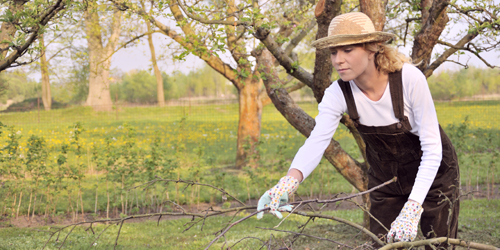
By Robert Bohinski, MD, PhD
As spring arrives with the lacy finery of emerging leaves, the explosion of weeds, and the chorus of birds at dawn, our thoughts are inevitably drawn to the need for yard of work. And this year more than ever, with so many of us sheltering at home during the coronavirus pandemic, we are likely to embrace the prospect of getting outside and into some sunshine.
Unfortunately, many of us will be destined to limp away from this rite of spring with a classic case of lower back strain – the most common back injury known to DIY yard-workers everywhere.
I confess that I know this first-hand. Many years ago I violated my own best medical advice while moving heavy walking stones in my yard. There I was, the neurosurgeon who knows the physics (and limits) of the spine as well as anyone, tugging mightily on one of the stones to loosen it from the ground. I was stooped over, my legs weren’t sufficiently bent, and my spine was not in a neutral position. Without warning, the pain of a textbook “acute lumbar strain” struck like a bolt of lightning. I was immediately incapacitated, unable to stand up straight. I hobbled back to the house, a typical 30-something guy who still thinks he’s young and invincible and able to do anything if he puts his mind to it. Next, and equally humbling, I explained this to my wife.
I then followed the advice I would give a patient: apply ice, rest, and take over-the-counter anti-inflammatories as directed. Acute lumbar strain can worsen in the hours following the initial injury, and people complain about the inability to stand up or rise from a seated position without help. Because any attempt at movement often results in sharp, disabling pain, sitting in a comfortable chair and watching TV for the rest of the weekend definitely can help.
Fortunately, acute lower back strain usually resolves after two to seven days. My episode lasted five days, and I’ve had no problems since, partly because I have gone back to the advice I give everyone else, which is to work smarter, not harder.
If lumbar strain were the only kind of back injury, of course, I would not be employed as a spine surgeon. About 20 percent of back injuries or disorders do require surgical intervention — operations that range from 1-hour, micro-surgical procedures for a herniated disc to 20-hour reconstructions of spines ravaged by deformity or degenerative disease. Signs of a more serious back problem include pain radiating into the legs, with numbness and tingling in both legs; difficulty urinating; and numbness or tingling in the groin area, which is particularly worrisome. If the pain is out of proportion, or if it’s something never experienced before, the primary care physician should be called. If pain lasts longer than five to seven days, if pain worsens, or if new symptoms develop, calling the doctor is also advised.
Our most common surgical procedure at Mayfield Brain & Spine involves treatment of a herniated disc. Discs, which are situated between the vertebrae in the spine, act as shock absorbers and keep the vertebrae from rubbing against each other. A herniation occurs when the gel-like material inside a disc protrudes and presses against a nerve that runs down the leg. Although these injuries can occur two to four weeks after a lumbar strain, they generally occur spontaneously. A herniated disk, also known as sciatica or a pinched nerve, often responds well to a course of treatment with oral prednisone and activity restrictions, occasionally combined with physical therapy. About one in 10 people who have disc herniation end up with some kind of surgical intervention. In those cases we can shave off the fragment of material in a one-hour procedure accomplished through a micro-incision of an inch or less. Patients typically go home the same day.
While most complex spinal problems are related to age, genetic makeup, or traumatic injury and are therefore not easily prevented, simple (though painful) injuries like acute lumbar strain can be avoided with proper back care. Here are the basic guidelines for prevention:
• Strengthen the core abdominal and back muscles to take some of the workload off the supporting elements of the spine.
• Maintain proper alignment, or posture, to reduce stress on the back. Patients with chronic problems often benefit from working with a physical therapist to learn how to walk and sit.
• Maintain proper weight for your height. Excess abdominal fat causes strain on the posterior spinal muscles.
• Join a club and consult a trainer if possible to ensure that the exercises you are doing are right for you.
• Start slowly and build up a tolerance for activities. Don’t dive right in. It’s the diving in that results in acute strains or tears.
• Ask for help if you’re moving heavy loads.
Most people who undergo treatment, either surgical or nonsurgical, can return without restriction to their previous employment and leisure activities, including golf, tennis, skiing, biking, hiking, and – dare I say it – yard work. Well, maybe there is one restriction. When faced with “back-breaking” tasks like mulching, lifting, digging, and moving walking stones, take the advice of a spine specialist who knows: work smarter, not harder.
Robert Bohinski, MD, PhD, is a neurosurgeon with Mayfield Brain & Spine.